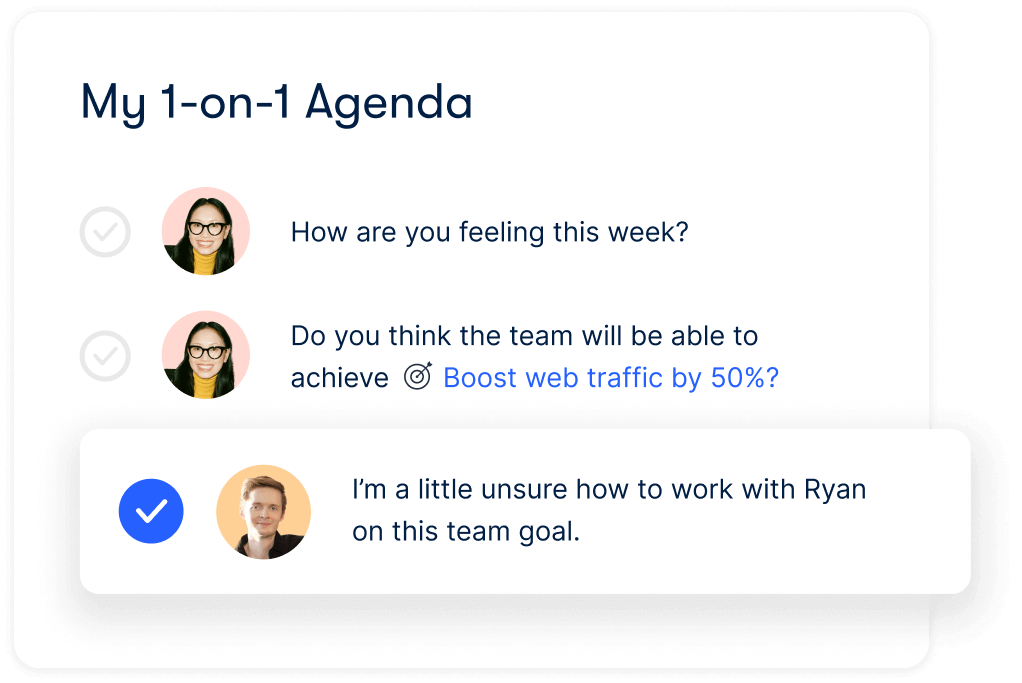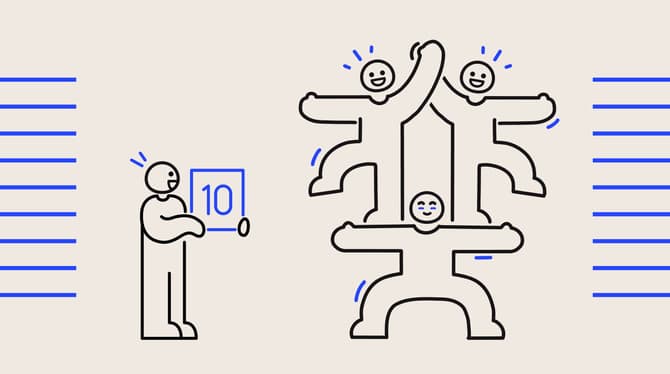Is maintaining a schedule of virtual one-on-one meetings the first thing that gets dropped when your calendar starts to fill up? We get it. But we’re here to share why remote one-on-one meetings should be at the top of your priority list.
To start, ongoing communication between managers and employees leads to better team alignment, stronger employee performance, and higher job satisfaction for the people on their team.
When you’re working remotely, it’s easy to feel disconnected. The disconnect can be even more prominent in the manager-employee relationship and is a key reason to prioritize virtual one-on-one meetings. Without these regular syncs, managers can feel like they’re not keeping up with their direct reports, while employees may start to feel unseen.
In the era of Zoom fatigue and opting for more asynchronous communication, any recurring meeting risks starting to feel redundant. But don’t let remote one-on-ones fall to the wayside! With a little bit of effort, you can make these critical meetings as productive and impactful as they were at the office—maybe even more so.
Exclusive online summit
·
May 23 2024
Moments that matter: how to seed great work
The important role of one-on-one meetings for remote and distributed teams
Our research into the distributed workforce has taught us that the thing remote and hybrid teams struggle most with is connection.
Remote workers often start to feel disconnected from their work, team, manager, and company mission. Maintaining regular one-on-one meetings can help with this.
Remote managers’ meetings with individual team members help them stay up-to-date with everyone’s workload, goal progression, and any challenges they’re facing. And for employees, one-on-ones help them keep their manager informed and drive their career development.
But beyond all the practical benefits of one-on-one meetings, there is the human benefit. When managers and employees talk regularly, they maintain their personal connection. From maintaining trust to spotting signs of disengagement or dissatisfaction, this dedicated time is essential for managers to support their direct reports properly.
In-person vs. virtual one-on-ones: what’s the difference?
There are a few key differences between virtual one-on-ones and in-person meetings. These factors can pose challenges for making remote meetings feel authentic and productive. Here’s an overview:
In person one-on-ones
- Easier to pick up on nonverbal cues like body language
- Can be done in a more casual setting, like at a coffee shop
- Going back-and-forth is easier and conversation flows
- Casual check ins feel more natural
Virtual one-on-one meetings
- A video call can be a barrier to complete communication
- Usually happen from a workstation, at home or the office
- Each person takes turns speaking so as not to interrupt
- Small talk may feel stilted
Once you acknowledge some of these differences, they’re easier to account for. Don’t worry, we’ve got you covered with tips and ideas to make every one-on-one meeting better, no matter how it happens.
Running effective one-on-one meetings with remote employees
To make the most out of your time together, it’s important to run your one-on-ones effectively. Some of the best practices for virtual one-on-ones are the same as in-person meetings, but they’re worth keeping in mind.
Before your remote one-on-one
Ahead of your virtual one-on-one meeting, make sure to set some talking points and create a shared meeting agenda. A shared agenda helps both a manager and their direct report know what they’ll be discussing. It’s easier to arrive prepared!
Select from dozens of one-on-one meeting agenda templates in Officevibe.
During your one-on-one virtual call
A meeting check-in is always a great way to start video calls. Getting a sense of how both people are coming into the meeting helps you start things off on the right foot. Ask questions, cover your talking points, and remember to take meeting notes.
Not sure what to ask? Select from our 40 one-on-one questions for busy managers.
After your one-on-one meeting
No matter what you discuss in your one-on-one meeting, it’s always important to follow up. Send a quick recap of the key takeaways and any next steps from your meeting, and set any agenda items to revisit next time.
Pro tip: At the end of every one-on-one, send a calendar invite for your next meeting and set some discussion points you’d like to follow up on.
The power of virtual one-on-one meeting software
Did you know you can use a one-on-one software like Officevibe to plan, carry out, and keep track of every meeting? Having productive conversations is easy with a collaborative meeting agenda where managers and employees can add talking points. And it’s easy to stay organized and keep track of what you discussed in past meetings when your notes are all stored in one place.

5 Tips for better virtual one-on-one meetings
These 5 one-on-one meeting tips help you have more productive and impactful remote one-on-ones.
- Share feedback, and ask for it. It’s always a good idea for managers and their direct reports to exchange constructive feedback. The more people make a point of it, the more it becomes second nature.
- Opt for video calls whenever possible. Sure, phone calls can be a nice break from back-to-back remote meetings. But to have effective one-on-ones, it’s worth it to have that face-to-face communication.
- Discuss career progression. Career conversations are essential for employee engagement, personal growth, and long-term retention. Make a point of setting and tracking goals and focusing on development.
- Practice active listening. When managers ask one-on-one questions, they should strive to really listen to what their direct report shares. Turn off notifications and your second screen, and focus on what’s happening in the virtual meeting room.
- Save status updates for team meetings. Everyone on your remote team can benefit from a project update, so use your time together for these discussions. A one-on-one meeting should focus on the individuals’ needs, goals, and challenges.
Ideas to make remote one-on-ones more energizing
Like all remote meetings, virtual one-on-ones can start to feel draining when it’s just another meeting time booked in your calendar. But it doesn’t have to be this way! Here are some ideas to make your remote one-on-ones more energizing and engaging.
- Switch up your remote work environment. Try taking your video call from a different room, or step outside.
- Establish a new ritual. Reserve your first 5 minutes for making a cup of tea or coffee together while you check in.
- Make it a walk and talk. Switch off your video and take a walk around the block while you chat on the phone.
Keep virtual one-on-one meetings refreshing and productive
Every time a manager meets with a direct report, they have the chance to understand each other better and drive team member performance, engagement, and success. Remote work doesn’t have to be a barrier to making these recurring meetings count. Make the most of every remote one-on-one with the tips, best practices, and fresh ideas outlined in this article.



